Thai Seafood: Beachside Eats & Fish Market Guide
Thailand’s long coastline is a treasure trove for seafood fans. With over 2,500 kilometres of beaches, you can find fresh catches everywhere. Enjoy dishes like spicy tom yum soup and grilled prawns at beachside spots or local markets.
Exploring Thai cuisine is an exciting journey. You’ll find many authentic dishes to try. Whether walking on the beach or at a fish market, you’ll find plenty of seafood to enjoy.
As you explore beachside eats, you’ll discover Thailand’s seafood wonders. This guide will show you the top seafood markets, restaurants, and dishes to try. Get ready for a delicious adventure.
Discover the Flavours of Thai Seafood
Exploring Thai seafood takes you on a journey through the country’s rich culinary heritage. It shows its love for fresh, bold flavours. Thai cuisine is known for its diverse and vibrant seafood dishes. These dishes use fresh ingredients and traditional cooking techniques.

Regional Specialties You Must Try
Thailand’s regional specialties highlight the diversity of its seafood cuisine. Must-try dishes include Tom Yum Goong, a spicy and sour prawn soup, and Pla Rad Prik, deep-fried fish with chilli sauce. Each region in Thailand offers its unique take on seafood, making the country’s culinary landscape incredibly rich.
The Importance of Freshness
The freshness of seafood is key in Thai cuisine. Fresh ingredients make dishes not only delicious but also safe to eat. When visiting Thailand, you can see the emphasis on freshness at local fish markets and seafood restaurants.
Fresh seafood is chosen daily, and chefs take pride in preparing dishes that highlight the natural flavours of the ingredients. This commitment to freshness is a key element of the Thai seafood menu.
Traditional Cooking Techniques
Thai cooking techniques are deeply rooted in tradition. When it comes to seafood, these methods are used to bring out the best flavours. Techniques such as grilling, steaming, and frying are commonly used, often combined with herbs and spices to create complex and aromatic dishes.
For example, steaming seafood with herbs like lemongrass and galangal infuses the dish with fragrant flavours. Grilling adds a smoky depth. Understanding and appreciating these traditional cooking techniques can enhance your experience of enjoying Thai seafood.
Best Beaches for Thai Seafood Dining
Thailand’s stunning beaches are perfect for enjoying the freshest seafood. Here, dining meets breathtaking views, creating an unforgettable experience.

Beachfront Restaurants to Visit
Thailand boasts many exceptional beachfront restaurants. They offer a unique dining experience with the sound of waves and fresh seafood smells. Top spots include Phuket, Koh Samui, and Krabi, known for their outstanding seafood dishes and beautiful views.
Sunset Dining Experiences
Dining at Thailand’s beaches during sunset is a highlight. Many restaurants have stunning sunset views, making meals memorable. Enjoy a romantic dinner or a casual meal with family and friends while watching the sun set.
Casual Eateries Along the Coast
Thailand’s beaches also have casual eateries for delicious seafood at affordable prices. These places offer a relaxed atmosphere, perfect for a quick bite or a leisurely meal. You can find traditional Thai dishes and international cuisine, all made with fresh, local ingredients.
Whether you seek a luxurious dining experience or a casual meal, Thailand’s beaches have it all. With their beautiful scenery, fresh seafood, and welcoming atmosphere, they are a must-visit for seafood lovers.
Exploring Thai Fish Markets
Thai fish markets are a treasure trove of seafood. You’ll find everything from classic dishes to rare treats. The lively atmosphere and wide variety of seafood cater to every palate.
Must-Visit Locations in Thailand
Thailand boasts many fish markets that seafood lovers must see. Some top spots include:
- The bustling streets of Bangkok’s Chatuchak Weekend Market, where you can find a wide variety of fresh seafood.
- The historic Samut Sakhon Fish Market, known for its traditional seafood offerings.
- The vibrant night markets of Phuket, where you can sample local seafood delicacies.
These markets offer a peek into Thailand’s seafood culture. They also let you taste some of the freshest seafood around.
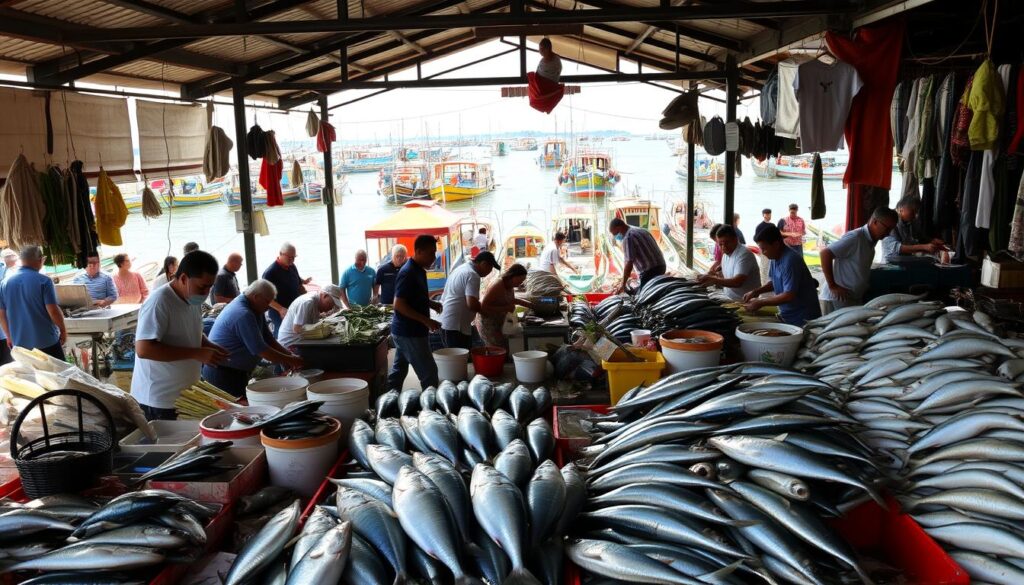
What to Look for When Buying Seafood
When buying seafood at Thai fish markets, look for a few key things. This ensures you get the best quality. Consider:
- Freshness: Choose seafood that looks and smells fresh.
- Variety: Thai fish markets have a wide range of seafood. Be adventurous and try something new.
- Sustainability: Pick seafood that’s sustainably sourced. This supports local fishermen and marine conservation.
Tips for Flexibility in Your Choices
Being open to different seafood options can make your dining experience better. Consider:
- Trying seasonal seafood, which is often fresher and more flavourful.
- Exploring different cooking methods, such as grilling or steaming, to bring out the unique flavours of your chosen seafood.
- Experimenting with various seafood recipes to find your new favourite dish.
By embracing new experiences and options, you can fully enjoy the culinary wonders of Thai fish markets. From a Thai seafood menu to famous Thai seafood dishes, there’s something for everyone.
Popular Thai Seafood Dishes
Exploring Thailand’s seafood dishes is a must. Thai food is known for bold flavours and spices. You’ll find everything from spicy soups to stir-fried noodles.
Tom Yum Goong: A Spicy Delight
Tom Yum Goong is a famous Thai dish. It’s spicy and sour, with prawns, lemongrass, and mushrooms. The mix of flavours is refreshing and invigorating.
Fresh ingredients are key to a great Tom Yum Goong. Fresh prawns and herbs make it full of flavour. You can adjust the spice level to suit your taste.
Pla Rad Prik: Deep-Fried Fish with Chilli Sauce
Pla Rad Prik is perfect for those who like spice. It’s deep-fried fish with a spicy chilli sauce. The fish’s crispy outside and the tangy sauce are a great match.
The dish’s beauty is in its simplicity and quality. Fresh fish and a good chilli sauce make it special. The sauce adds a depth of flavour.
Seafood Pad Thai: A Classic Twist
Seafood Pad Thai is a beloved dish worldwide. It’s stir-fried noodles, seafood, bean sprouts, and peanuts in a sweet and sour sauce.
Pad Thai is versatile, but seafood is a favourite. The mix of textures and tangy sauce is satisfying. You can choose your seafood and spice level.
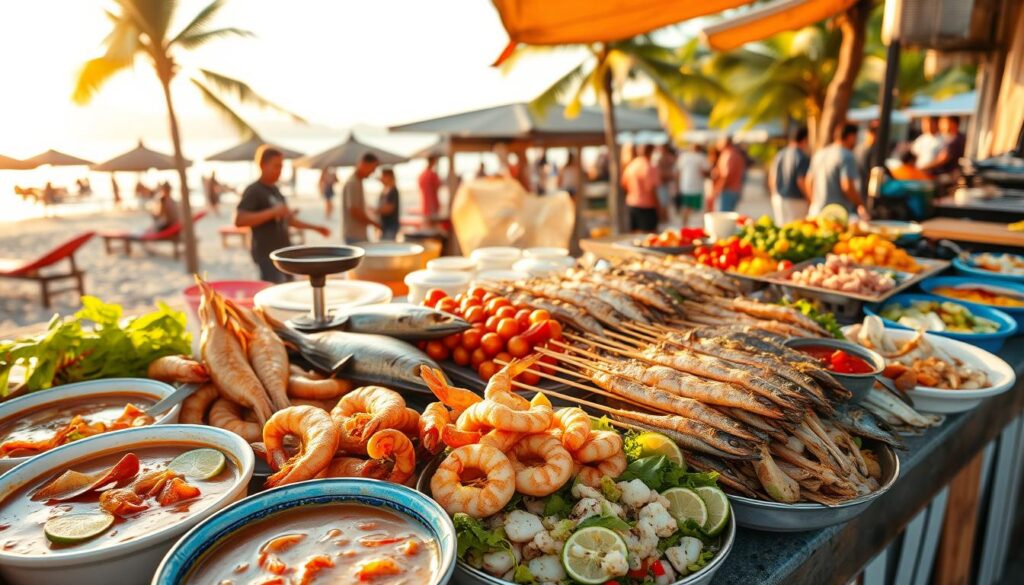
These dishes show the variety and richness of Thai cuisine. Whether you want something spicy, sour, or sweet, there’s a dish for you.
Street Food: Seafood at its Best
Exploring Thai street food reveals a world of fresh, tasty seafood dishes. The street food scene in Thailand is a culinary adventure. It offers a wide range of seafood options, from grilled fish to spicy tom yum soup.
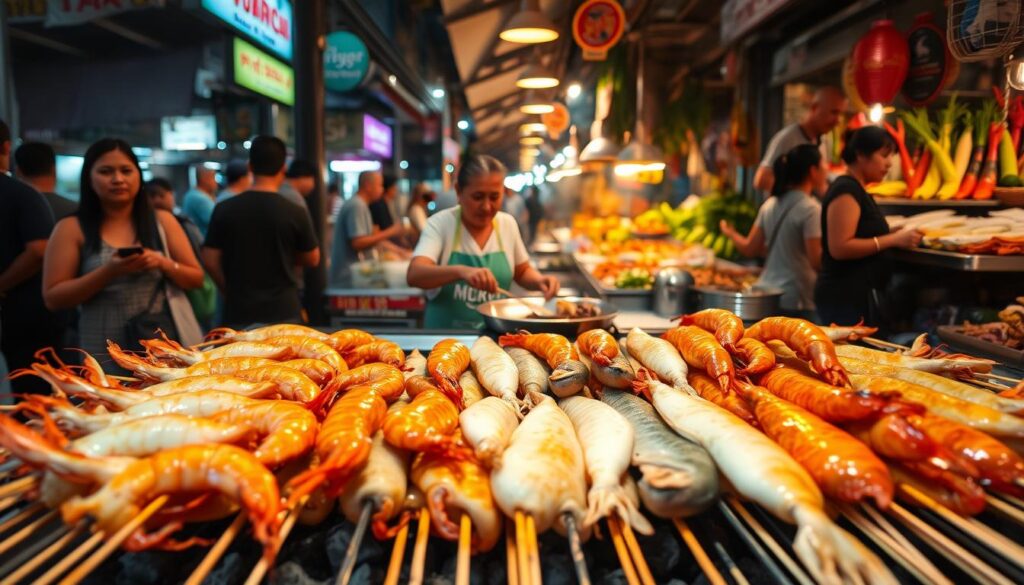
Night Markets: Vibrant Locations
Night markets are a key part of Thai street food culture. They offer a lively atmosphere where you can try many seafood dishes. These markets are more than just food; they’re an experience. Vendors call out, and the smell of sizzling seafood fills the air.
Some of the best night markets for seafood include:
- The famous Patpong Night Market in Bangkok
- The bustling streets of Chiang Mai’s Night Bazaar
- The seaside night markets in Phuket and Hua Hin
Local Specialties to Sample
At Thai night markets, there are many seafood specialties to try. You’ll find fresh grilled prawns, spicy seafood tom yum soup, and fried fish with various sauces.
Don’t miss out on unique dishes like steamed mussels in a spicy coconut milk sauce or grilled squid with a tangy dipping sauce. The freshness and bold flavours make for a memorable dining experience.
Casual Atmosphere and Fresh Ingredients
Eating at Thai street food stalls is a casual delight. You can sit at simple plastic tables, often under the stars. The lively atmosphere of vendors and shoppers adds to the experience.
The focus on fresh ingredients is a key feature of Thai street food. Vendors are proud of using the best seafood. This ensures every dish is delicious and of high quality.
Sustainable Seafood Practices in Thailand
The future of Thai seafood relies on sustainable practices. These protect the environment and support local communities. Understanding sustainability can make your dining experience better.
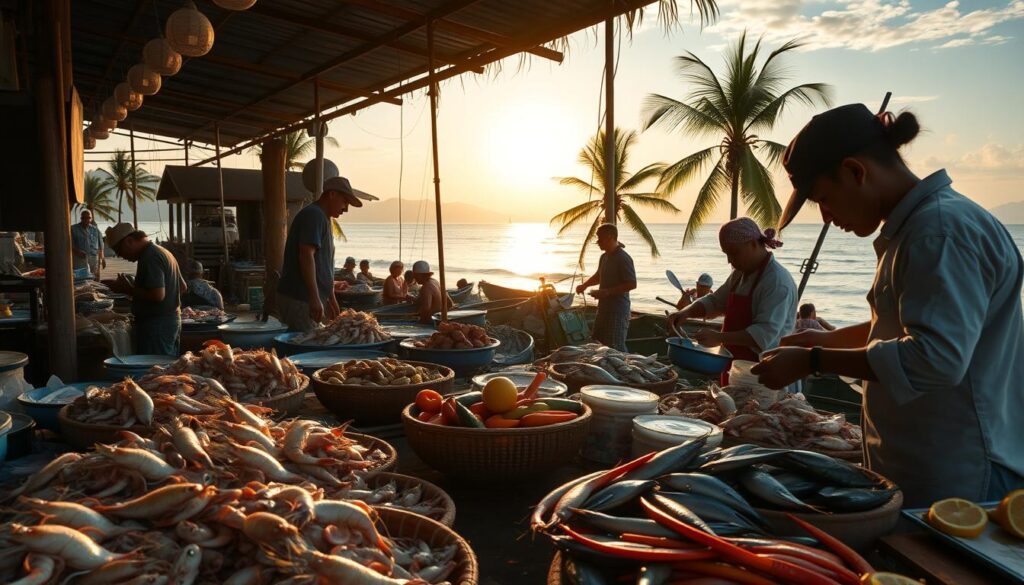
Impact on Local Fishermen
Sustainable seafood practices help local fishermen a lot. They affect their jobs and how they work. By picking sustainable seafood, you help these communities.
- Fair prices for fishermen
- Improved working conditions
- Support for local economies
Importance of Marine Conservation
Marine conservation keeps our oceans healthy. Thailand’s seas are full of life, and we must protect them. This is key for seafood’s future.
Key conservation efforts include:
- Protecting marine habitats
- Regulating fishing practices
- Promoting eco-tourism
How You Can Support Sustainable Choices
You can help make seafood more sustainable. Here are ways to do it:
- Choose seafood from sustainable sources
- Support local, small-scale fishermen
- Spread awareness about sustainable seafood
By making smart choices, you help the seafood industry. This benefits the environment and local people.
The Role of Spices and Herbs in Thai Seafood
Spices and herbs are key in Thai seafood, adding depth and complexity. They enhance flavour and aroma, making Thai dishes special.
Common Ingredients Used
Thai seafood recipes use many spices and herbs. Some top ones are:
- Lemongrass, known for its citrusy flavour
- Galangal, which adds a pungent, earthy taste
- Chilies, contributing a spicy kick
- Thai basil, providing a sweet, anise-like flavour
- Kaffir lime leaves, which add a unique, citrusy note
Balancing Flavours for Perfect Dishes
Getting flavours right is key in Thai seafood. It’s about mixing salty, sweet, sour, and spicy. For example, in Tom Yum soup, chilies’ heat is balanced by lime’s sourness and seafood’s sweetness.
Tips for Balancing Flavours:
- Taste as you go to adjust the seasoning
- Use a variety of ingredients to achieve a balanced flavour profile
- Don’t be afraid to experiment with different spice levels to suit your taste
Influences from Regional Cuisines
Thai cuisine varies by region, affecting how spices and herbs are used. Southern Thai dishes are spicier, while northern ones use more herbs like cilantro and basil.
Knowing these regional differences helps you enjoy Thai seafood’s diversity. You can try different recipes to find your favourites.
Pairing Beverages with Thai Seafood
Finding the right drink to go with Thai seafood is an art. It makes the flavours pop. In Thailand, locals carefully choose drinks that match their seafood. Whether at a beach restaurant or a night market, the right drink can make your meal better.
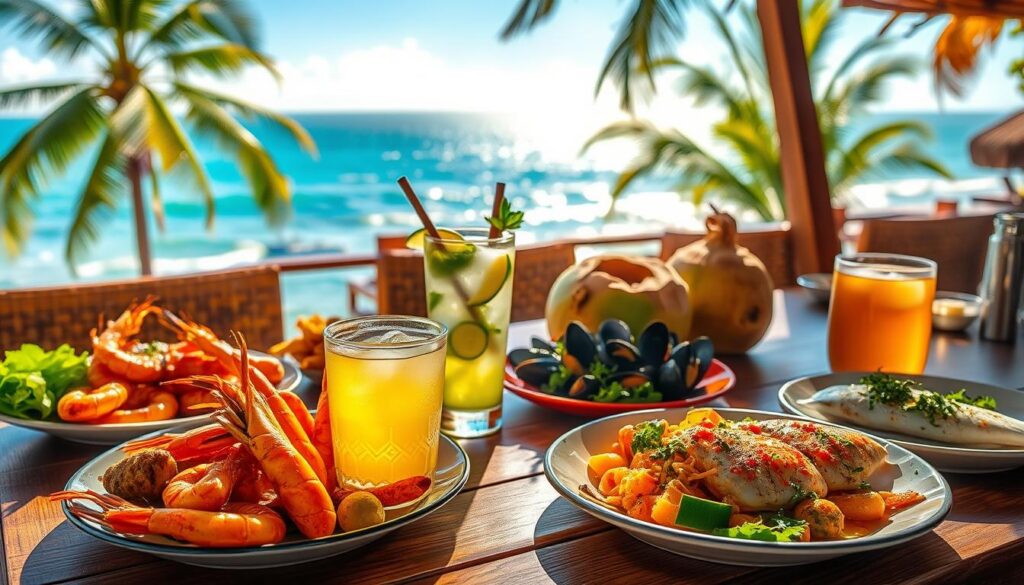
Best Wines and Cocktails
Western drinks like wine and cocktails also pair well with Thai seafood. A dry Riesling or a crisp Sauvignon Blanc can enhance seafood flavours. For cocktails, a Thai Basil Gimlet or a Lemongrass Martini is refreshing. These drinks balance the spiciness in Thai food.
Traditional Thai Beverages
Thailand has its own drinks that go great with seafood. Singha beer, a Thai lager, is crisp and pairs well with grilled seafood. For something non-alcoholic, try Thai Iced Tea or coconut water. These drinks are key to the Thai dining experience.
Understanding the Role of Pairing
Choosing a drink with Thai seafood is more than picking a drink. It’s about making the meal better. The right drink can balance flavours, cut spiciness, and highlight seafood freshness. Knowing how to pair drinks makes your meal memorable.
When trying Thai seafood, ask for drink pairing tips. Locals and chefs offer great advice. Whether you love wine or traditional Thai drinks, you’ll find the perfect match.
Top Tips for Cooking Thai Seafood at Home
Want to bring the taste of Thailand to your kitchen? Our top tips will help you cook delicious Thai seafood. With a few simple techniques and the right ingredients, you can impress your loved ones with authentic Thai dishes.
Essential Kitchen Equipment
To cook Thai seafood well, you need some key kitchen tools. A wok or large frying pan is essential for quick stir-frying. You’ll also need a sharp knife for chopping and a mortar and pestle for grinding spices.
Key equipment includes:
- A wok or large frying pan
- A sharp knife
- A mortar and pestle
- A steamer basket for steaming seafood

Recommended Recipes for Beginners
For beginners, start with simple Thai seafood recipes. Tom Yum soup is a great choice, with its spicy and sour flavors. It’s made with a flavorful broth, lemongrass, and your favorite seafood. Another easy recipe is Thai-style grilled fish, marinated in a mix of fish sauce, lime juice, and herbs.
Simple recipes to try:
- Tom Yum soup with prawns
- Thai-style grilled fish with herbs
- Stir-fried squid with chillies and basil
Common Mistakes to Avoid
When cooking Thai seafood, avoid common mistakes. Overcooking seafood makes it tough and rubbery. Not preparing ingredients before cooking can make the process chaotic. Also, not balancing flavors can result in an unbalanced taste.
Mistakes to avoid:
- Overcooking seafood
- Not preparing ingredients in advance
- Failing to balance flavors
Cultural Significance of Seafood in Thai Cuisine
In Thailand, seafood is more than just food. It’s a big part of the country’s culture. Seafood is seen in many parts of Thai life, like festivals and family traditions.
Festivals Celebrating Seafood
Thailand has many festivals that celebrate seafood. The Phuket Seafood Festival is a big one. It draws people from all over the world.
At this festival, you can try lots of seafood dishes. From curries to grilled fish, there’s something for everyone.

Seafood in Thai Family Traditions
Seafood is key in Thai family traditions. It’s a big part of special occasions and holidays. For example, during Thai New Year (Songkran), families come together for seafood meals.
This shows good luck and prosperity.
The Influence of Religion on Seafood Consumption
Religion affects how Thais eat seafood. Being mostly Buddhist, many follow principles of compassion and sustainability. This shows in their seafood choices and how it’s caught.
Choosing sustainable seafood helps your meal and the ocean. It’s good for your taste buds and the environment.
Planning Your Visit to Thailand for Seafood Adventures
Planning a seafood trip to Thailand is exciting. It’s a paradise for those who love seafood. Think about the best times to enjoy fresh seafood and useful travel tips to make your trip better.
Best Times to Savour Thai Seafood
The best time for seafood in Thailand is from October to February. The sea is calm, and there’s a wide variety of seafood. Planning your trip for these months will make it more enjoyable.
Getting Around and Planning Your Itinerary
Traveling in Thailand is easy thanks to its good transport system. You can fly, take buses, or trains to get to seafood spots. Local transport like tuk-tuks or cars helps you see more. Visit famous fish markets and beach restaurants for a full seafood experience.





